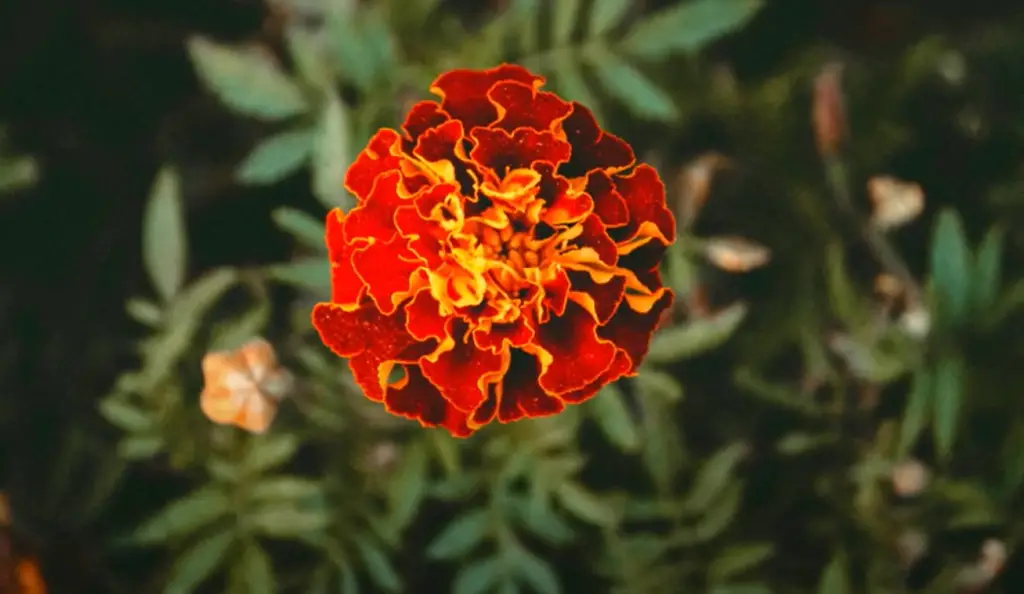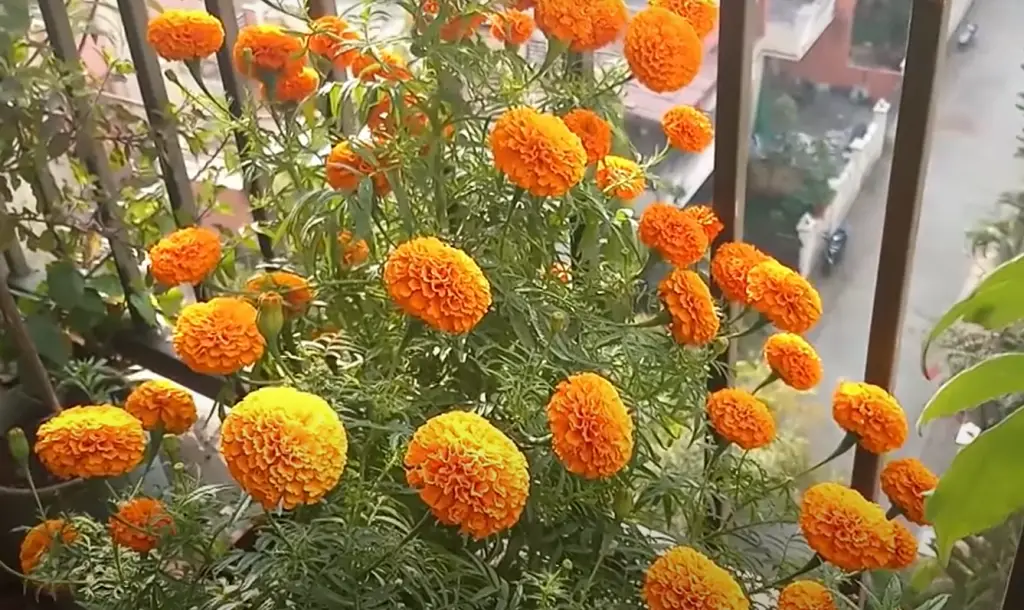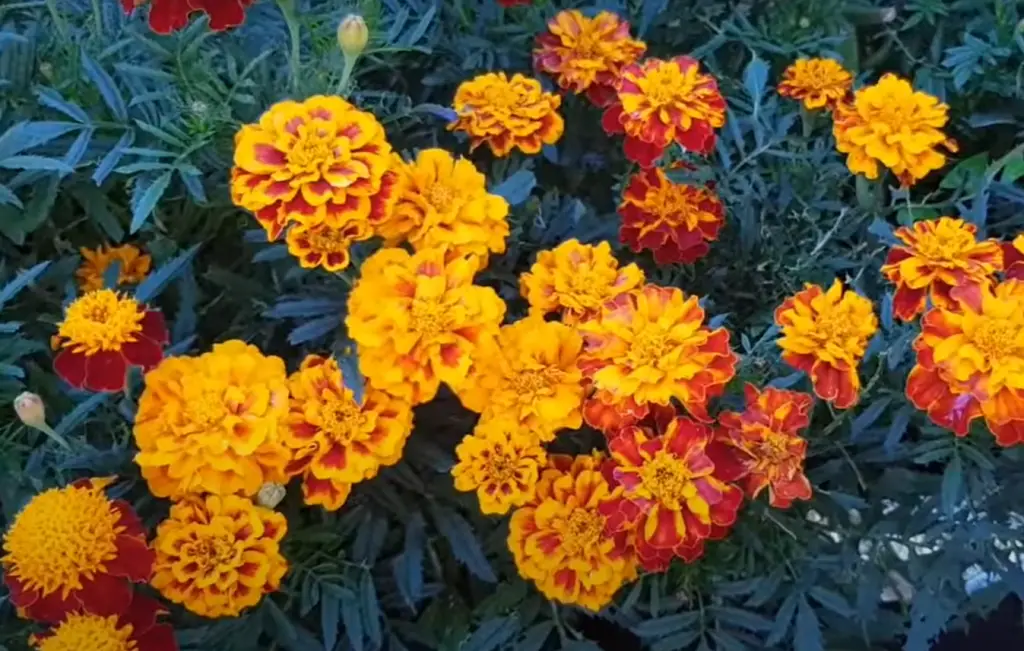When you think of a garden, marigolds are often the first flower to come to mind. Whether you’re just starting out with your first garden or have been gardening for years, it can be difficult to come up with new ideas for Marigold gardens. Fortunately, there are plenty of creative ways to grow and use this cheerful flower.
In this article, we’ll go over everything you need to know about Marigolds and their ideal growing conditions, as well as some unique ideas on how to incorporate them into your garden.
We’ll also provide helpful tips and tricks for the best results when designing your own Marigold Garden!
What Is the Best Way to Grow Marigolds?
Before you can start coming up with your own Marigold Garden ideas, it’s important to understand the best way to grow these flowers.
Most varieties of Marigolds prefer full sun and well-drained soil. They are also drought tolerant, so they don’t need a lot of water or fertiliser.
If you’re looking to save time and energy, Marigolds are a great choice for busy gardeners. [2]
Landscaping With Marigolds
Marigolds are a great addition to any outdoor space, as they can add both aesthetic and practical value.
Where to Plant Marigolds
When it comes to designing your Marigold Garden, there are a few things to keep in mind. First, make sure you’re planting them in an area that gets plenty of sunlight—at least six hours per day.

You can also consider planting them near the edge of your garden beds or along pathways for easy access and added visual impact.
Finally, keep in mind that Marigolds can spread quickly, so be sure to space them out accordingly. This will help prevent overcrowding and ensure that your garden looks its best.
Marigold Garden Ideas
Protection For Your Veggies
Marigolds make a great natural pest deterrent and can be used to protect your vegetable garden from unwanted bugs.
Planting clusters of Marigold flowers around the perimeter of your veggie patch will help keep out pests like aphids, moths, and beetles.
Mixed Flowers In A Wood Container
Nothing adds a pop of colour quite like a Marigold Garden. Mixing different colours and varieties of these flowers in a wooden container or raised bed is an easy way to bring life to any outdoor space. [1]
Striking Concrete Planters
Marigolds are a great choice for brightening up your patio or balcony. Planting these cheerful flowers in striking concrete planters will create an eye-catching display that you’ll love coming home to.
Bordering A Flower Garden
Marigolds are perfect for adding an extra layer of vibrancy to any flower garden. Planting a few at the feet of larger blooms will bring a cheerful touch and create a beautiful border.
Utilising A Spare Fountain
Do you have an unused fountain in your backyard? Planting Marigolds around the perimeter of a water feature is an easy way to transform it into a stunning centrepiece.
Letting Them Grow Free
Why not let your Marigolds run wild in a designated corner of the garden? Allowing them to sprawl and spread their seeds creates a unique and delightful flower bed that you’ll love coming home to.
Creating A Butterfly Hangout
Marigolds are a great way to attract butterflies and other pollinators to your garden. Planting them in clusters of their own or mixing different varieties will provide a lovely nectar source for these beautiful creatures.
Creating A Walkway For Your Home
Planting a Marigold border along your walkway is a quick and easy way to spruce up your entrance. The bright blooms will instantly transform the look of your home, creating an inviting first impression for visitors.
Where Should You Plant Marigolds?
When designing your Marigold Garden, remember that these cheerful flowers prefer full sun and well-drained soil. You can plant them around the edge of your garden beds or along pathways for easy access and added visual impact.

Keep in mind that Marigolds can spread quickly, so be sure to space them out accordingly. With the right care and consideration, you’ll soon have a beautiful Marigold Garden that you’ll love coming home to.
What Month Is Best To Plant Marigolds?
In most areas, the best time to plant Marigolds is in late spring or early summer. This will give them enough time to establish themselves and bloom in time for summer.
How Many Hours Of Sunlight Do Marigolds Need?
Marigolds need at least six hours of direct sunlight per day to grow and bloom optimally. Planting them in an area that gets plenty of natural light will ensure they get the nutrients they need for a healthy growth cycle.
Do Marigolds Grow Better In Tropical Conditions?
Marigolds are native to semi-tropical climates and do best in hot, humid weather. Planting them in tropical conditions will ensure they bloom abundantly and provide you with a colorful display all summer long.
FAQ
Where should I put marigolds in my garden?
Marigolds should be planted in an area where they will receive full sun for at least six hours a day. Planting them around the edge of your garden beds or along pathways is a great way to add color and interest to your outdoor space.
What month is best to plant marigolds?
The best time to plant Marigolds is in late spring or early summer. This will give them enough time to establish themselves and bloom before the heat of summer arrives.
Do marigolds need special soil?
Marigolds prefer well-drained, slightly acidic soil. Adding a light layer of mulch around their base can help retain moisture and protect them from extreme temperatures.
Do marigolds need to be fertilised?
Marigolds do not require extra fertiliser to thrive, but you can give them a light boost with an organic fertiliser every few weeks. This will help keep them healthy and encourage more blooms throughout the season.
Does planting marigolds attract pests?
Marigolds are known for their ability to naturally repel garden pests, including aphids, mosquitoes, and beetles. Planting them around the perimeter of your garden can help keep these pesky critters away from your other plants.
What looks good with marigolds?
Marigolds pair beautifully with other bright and vibrant flowers, such as petunias, impatiens, and daisies. Planting a variety of different colours will create an eye-catching display that is sure to bring life to your garden.
What should you not plant next to marigolds?
Marigolds are sensitive to certain chemicals and may suffer when planted too close to plants like tomatoes and potatoes, which often require fertilisers or insecticides.

To avoid any potential damage, be sure to keep these types of plants away from your marigolds.
Are marigolds good to plant around a garden?
Yes! Marigolds are a great way to add color and interest to your outdoor space. Plus, they’re known for their natural ability to repel garden pests, making them an ideal choice for protecting your other plants.
Do marigolds require special care?
Marigolds are easy to care for and do not require any special attention. They prefer well-drained, slightly acidic soil and should be watered regularly to ensure optimal growth and blooming. A light layer of mulch around their base can help retain moisture and protect them from extreme temperatures.
How many marigolds can you plant together?
It is best to plant marigolds in small clusters of three or four plants. Planting them too close together may cause overcrowding and inhibit their growth, so be sure to give each one enough space to spread out.
What are the benefits of planting marigolds?
Marigolds make excellent additions to any garden as they provide a burst of color, attract pollinators, and naturally repel garden pests. They are also easy to care for and require minimal maintenance. Planting them in your outdoor space is sure to bring life and beauty to any landscape.
Are coffee grounds bad for marigolds?
While coffee grounds are beneficial for some plants, they can be toxic to marigolds. Marigolds prefer a slightly acidic soil, so it is best to avoid using coffee grounds around them.
Instead, opt for an organic fertiliser every few weeks to help keep them healthy and encourage more blooms throughout the season.
What is the best way to harvest marigolds?
When harvesting marigolds, it is best to wait until the flowers are fully open and cut them at the stem. This will help ensure that all of the petals are intact and prevent any damage to the plant itself. The blooms can then be used for bouquets or other decorations.
Marigolds can be a delightful addition to any garden, providing vibrant color and natural pest control.
With proper care and maintenance, they are sure to bring life and beauty to your outdoor space. Whether you’re looking for a pop of color or natural pest repellent, marigolds make an excellent choice!
What is the best time to plant marigolds?
The best time to plant marigolds is in early spring when the soil is still cool and moist. They can also be planted in the fall for late-season blooms. Make sure to space your plants at least six inches apart and provide them with plenty of sunlight and water.
What is the average lifespan of a marigold plant?
Marigolds are an annual flower, meaning they last for one growing season. Depending on the type, a marigold plant can typically bloom from June to October.

In colder climates, these plants may not survive the winter and will need to be replanted each spring.
What type of soil is best for marigolds?
Marigolds prefer a slightly acidic soil with lots of organic matter. A combination of compost and topsoil works well, or you can add lime to the soil for an extra boost in acidity.
Be sure to water your plants regularly to keep them healthy and encourage more blooms throughout the season.
Are there any plants that should not be planted near marigolds?
Marigolds should not be planted in close proximity to tomatoes, potatoes, peppers, and eggplants as they can attract the same pests.
Additionally, it is best to keep them away from cabbage and cauliflower as these plants are susceptible to a disease called black leg which can be spread by marigolds.
Planting a border of garlic or chives around your marigold bed may help deter pests and provide additional protection for your other plants.
What pests are attracted to marigolds?
Marigolds are known for attracting beneficial insects, such as ladybugs, lacewings, and hoverflies. These insects help to reduce the population of harmful garden pests, like aphids and caterpillars.
Additionally, certain types of marigolds have been found to repel mosquitoes and other flying insects. Planting a few in your outdoor space can help to naturally reduce the number of pests in your garden.
What colours do marigolds come in?
Marigolds come in a variety of colours, ranging from bright yellow and orange to deep reds and purples. They also come in a wide range of sizes, from tall single-stemmed varieties to low-growing, cascading plants.
No matter what look you’re going for, there is sure to be a marigold that will fit the bill!
What are some tips for caring for marigolds?
Caring for marigolds is relatively easy, as they require very little maintenance. Make sure to water them regularly and give them plenty of sunlight. Deadheading can help to encourage more blooms throughout the season.
Additionally, adding a few inches of mulch around the plants can help retain moisture and keep weeds at bay.
Finally, be sure to fertilise your marigolds every few weeks throughout the growing season to promote healthy growth and abundant blooms.
How do I harvest marigold blooms?
When Marigolds are ready for harvesting, you’ll be able to tell by their vibrant color. Cut the stems just above the bloom, making sure that all of the Harvesting marigolds is a simple process and can be done with either scissors or pruning shears.
It is best to do this in the morning when the flowers are still fresh, as this will help them last longer once they are cut. Make sure not to take too many blooms off at one time, as this can cause the plant’s growth to be stunted.
Are marigolds edible?
Yes! Marigolds are edible flowers and can be used as a garnish for salads, soups, and other dishes. They have a subtle citrusy flavour that many people find appealing. Additionally, their petals can be dried and used to make tea or added to baking recipes for an extra pop of color.

Just be sure to research the specific type of marigold you are using, as some varieties may be more bitter than others.
How can I use marigolds in my garden?
Marigolds are a great addition to any garden, as they can help repel certain pests and add color to your outdoor space. They also have the added benefit of attracting beneficial insects such as ladybugs and lacewings.
Planting them around vegetable beds or near fruit trees can help protect your plants from unwanted pests. Additionally, they can be used as a border to keep animals out and make a colorful statement in your garden.
How long do marigolds last?
Marigolds are annual plants, so they will only last for one growing season. If you want your marigolds to return the following year, you can save some of the seed heads and plant them in the fall.
Alternatively, you can purchase new marigold seedlings in the spring. Depending on the variety, marigolds may bloom for several weeks or even months.
How far apart should I plant marigolds?
The spacing of your plants will depend on the type and size of marigold you are using. Tall varieties should be planted at least 12 inches apart, while low-growing types can be spaced as close as six inches.
Additionally, it is important to remember that marigolds do spread quickly, so keep an eye on them and thin out any overcrowded spots.
How can I use marigolds to attract beneficial insects?
Marigolds are very attractive to beneficial insects, such as ladybugs and lacewings. Planting them near vegetable beds or fruit trees can help keep pests away from those areas.
Additionally, planting some in the centre of your garden will attract these helpful bugs and give them a place to lay their eggs. This will help ensure that your garden has a healthy population of beneficial insects to keep pests at bay.
How can I use marigolds to repel pests?
Marigolds have long been used as a natural pest repellent. Planting them around your garden can help keep away some common pests, such as aphids and slugs.
Additionally, the strong scent of marigolds is said to deter other insects, such as mosquitoes. Planting them in and around your garden beds can help keep these unwanted visitors away.
Why are marigolds important?
Marigolds are an excellent addition to any garden, as they can help repel unwanted pests and attract beneficial insects. Additionally, their bright colours can add a pop of life to your outdoor space.
They are also easy to care for and will often return the following year if you save some of their seed heads.
Why do marigolds bloom in the summer?
Marigolds are a warm-weather plant and typically begin to bloom in late spring. This is when temperatures start to rise and there is plenty of sunlight for their growth.

Depending on the variety, they may continue to bloom until late fall or even early winter. Additionally, deadheading spent blooms can help encourage more flowers to form.
Does the color of a marigold flower matter?
The color of a marigold flower can be an important factor when choosing which variety to plant in your garden. Different colours have different meanings and uses, such as orange and yellow being associated with happiness and joy.
Additionally, some varieties may be more attractive to beneficial insects than others. Researching the different varieties can help you decide which one is right for your garden.
Do marigolds need full sun?
Marigolds thrive best in full sun and will bloom more profusely with at least six hours of direct sunlight each day. That being said, they can also tolerate some shade and will still flower in partial sun.
Additionally, planting them in a sheltered area such as near a wall or fence can help protect them from strong winds.
Does deadheading help marigolds?
Deadheading spent blooms is an important part of caring for marigolds. Removing the old flowers will help encourage new ones to form, resulting in longer-lasting blooms.
Additionally, it will help keep your plants looking neat and tidy. Deadheading should be done regularly throughout the growing season.
Do marigolds need to be fertilised?
Marigolds are not heavy feeders and do not require a lot of fertilizer. If your soil is lacking in nutrients, then you can apply a balanced fertilizer every few weeks during the active growing season.
Additionally, adding some compost or aged manure will help provide additional nutrition for your plants.
Does watering affect marigolds?
Marigolds are fairly drought-tolerant and do not need to be watered frequently. However, they will benefit from a deep soaking once per week during periods of hot and dry weather.
Additionally, providing them with some shade during these hot months can help keep the foliage from wilting.
Do marigolds need to be pruned?
Regularly deadheading spent blooms is an important part of caring for marigolds, and this is the only pruning that they need. Pruning off the stems or foliage may cause them to become leggy and can reduce their flowering potential.
Additionally, if you are trying to encourage more compact growth, pinching off the tips of new shoots can help.
Does planting marigolds help with pest control?
Marigold plants have a strong scent that is said to deter some common garden pests such as aphids, slugs and mosquitoes. Planting them in and around your garden beds can help keep these unwanted visitors away.
Additionally, their bright colours can attract beneficial insects such as bees and butterflies into your outdoor space.
Are there any other benefits to planting marigolds?
Marigolds are a great addition to your garden for more than just pest control and color.
Additionally, their foliage and flowers make beautiful cut flowers that you can use for bouquets and other decorations.
Do marigolds require any special care?
Overall, marigolds are quite low-maintenance and do not need a lot of fussing over. As long as they get six hours of direct sunlight each day, regular watering and occasional fertilisation, they should thrive.
Additionally, adding some mulch around the plants can help keep the soil moist and reduce weeds. With the right care, you can enjoy beautiful blooms all summer long!
Does planting marigolds near vegetables help?
Planting marigolds near vegetables can help deter pests and improve overall garden health. Marigolds emit a strong scent that is said to repel common garden pests such as aphids, slugs and mosquitoes.
Additionally, their roots help release beneficial compounds into the soil that can improve the fertility of your garden beds.
Are there any other tips for growing marigolds?
When it comes to planting marigolds, the best time to do so is in the early spring when the soil has had a chance to warm up. Additionally, adding compost or aged manure can help provide additional nutrients for your plants.

Finally, deadheading spent blooms regularly will help encourage new ones to form, resulting in longer-lasting blooms. With the right care, your marigold garden will provide you with beautiful and fragrant flowers all summer long!
Can marigolds be grown in containers?
Yes, marigolds can be grown in containers! When planting them in pots, make sure to use a well-draining potting mix and provide adequate drainage. Additionally, you can add some slow release fertilizer to the soil when planting to help promote healthy growth.
Marigolds need at least 6 hours of sunlight each day, so make sure to place your container in an area that is sunny and receives plenty of light. With the right care, you will have beautiful flowers all season long!
Useful Video: Why YOU Should Plant Marigolds. EVERYWHERE.
Conclusion
Marigolds are a colorful and easy-to-grow addition to your outdoor space. They do not require much pruning, but deadheading spent blooms regularly will help encourage new ones to form.
Additionally, they can be used as a natural pest repellent and also help improve the fertility of your soil. Marigolds can be grown in both the garden and container gardens with some basic care. With the right care, you will be rewarded with colorful blooms all summer long!
Thank you for taking the time to learn about Marigold Garden Ideas. We hope this article has been helpful in providing useful tips and information on how to create a beautiful marigold garden. Best of luck with your garden!
References:
- https://gardentabs.com/marigold-landscaping-ideas/
- https://homeguides.sfgate.com/landscape-marigolds-27951.html










Leave a Reply
View Comments